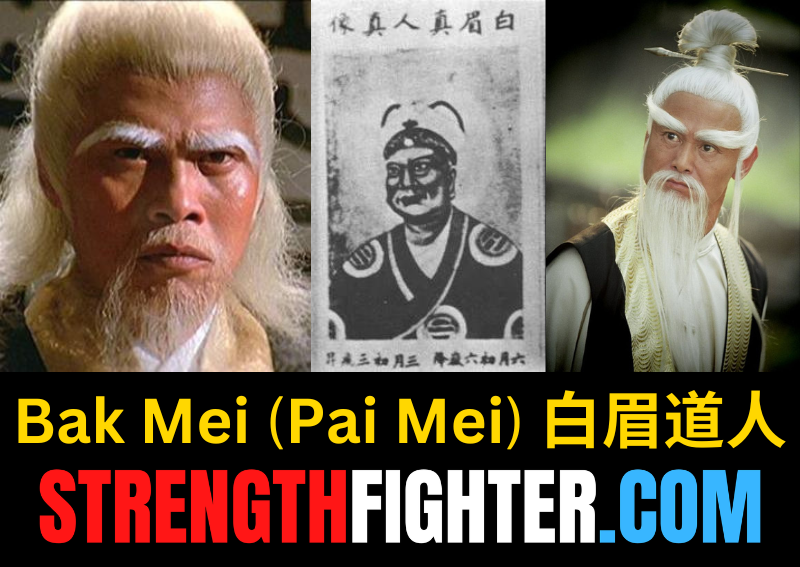Bak Mei aka Pai Mei 白眉道人

Not just a Kung Fu movies character, Pai Mei aka Bak Mei was a real Kung Fu Master and an historical figure.
Bak Mei (Pai Mei) 白眉道人. Literally “Taoist with White Eyebrows“. Speculated to be also known as Chu Long Tuyen.
Bak Mei, also known as Pai Mei, is one of the most enigmatic and feared figures in Chinese martial arts folklore. His name evokes images of white-haired, fierce-eyed masters capable of incredible feats of strength, speed, and combat prowess. Whether you’re a fan of martial arts movies, a practitioner of traditional Chinese martial arts, or simply curious about legendary fighters, Bak Mei is a name that commands respect and intrigue.
Origins of Bak Mei: A Complex Legacy
Bak Mei, translating to “White Eyebrows” in Cantonese, is both a historical figure and a mythological character. The real Bak Mei is said to have lived during the late Ming dynasty (1368–1644) and was a master of martial arts, particularly known for his expertise in a style that eventually took on his name: Bak Mei Kung Fu.
He was originally a monk of the Shaolin Temple, which has always been the cradle of Chinese martial arts. However, his story takes a darker turn as he is often depicted as a traitor to the Shaolin cause, aligning himself with the Qing Dynasty during their conquest of China. In some versions of the story, Bak Mei is one of the infamous “Five Elders” of Shaolin, who were among the few survivors after the temple was destroyed by Qing forces.
Bak Mei Kung Fu
Bak Mei Kung Fu is a Southern Chinese martial art that emphasizes explosive power, close-range combat, and precision strikes. It is a system designed for efficiency, focusing on ending a confrontation quickly and decisively. The style incorporates a unique blend of soft and hard techniques, allowing the practitioner to adapt to various combat scenarios.
Key Principles of Bak Mei Kung Fu:
- Short Power: Unlike other styles that rely on large, flowing movements, Bak Mei uses short, explosive bursts of energy. This is known as “ging” or “fa jing,” where power is generated from the entire body and released in an instant.
- Close-Range Combat: Bak Mei techniques are designed to be effective at close quarters, where most real fights occur. Elbows, knees, and short punches are heavily utilized.
- Internal Strength: Although Bak Mei is primarily seen as an external style, it incorporates elements of internal energy or “qi.” This blending of internal and external principles allows practitioners to generate significant power without telegraphing their movements.
Bak Mei is characterized by its emphasis on powerful close range hand strikes. Within Bak Mei can be found the four principles:
- Fou (Float)
- Chum (Sink)
- Tun (Swallow)
- Tou (Spit)
Common in the Southern Chinese martial arts like Ng Ying Kungfu (Chinese: 五形功夫), and also found in Karate.
Unique to Bak Mei is its classification of the following 6 powers:
- biu (thrusting)
- chum (sinking)
- tan (springing)
- fa (neutralizing)
- tung
- chuk
Bak Mei emphasizes the movements of the tiger. The traditions of Bak Mei Kung Fu trace its origins to Mount Emei, where Bak Mei is said to have transmitted the art to the Chan (Zen) master Gwong Wai, who transmitted the art to the Chan master Juk Faat Wan and the Taoist Fung Fo.
Hero or Villain?
Bak Mei’s legacy is complicated. To some, he is a symbol of treachery—a master who betrayed the Shaolin Temple and aligned with the Qing invaders. To others, he is a misunderstood figure, a martial artist who made difficult choices in turbulent times. This duality has fueled the legend of Bak Mei, making him a figure of both reverence and fear in martial arts lore.
In some martial arts communities, Bak Mei is still viewed with suspicion, his name synonymous with betrayal. Yet, his martial arts style continues to be practiced and respected, a testament to the effectiveness and depth of his knowledge.
The Enduring Legacy of Bak Mei
Whether seen as a villain or a martial arts genius, Bak Mei’s influence on Chinese martial arts and popular culture is undeniable. His techniques, philosophies, and the stories surrounding his life continue to inspire martial artists around the world. The legend of Bak Mei endures, a symbol of the complexity and depth of martial arts history.
So, the next time you see a white-haired master in a martial arts movie, remember that the character likely draws inspiration from the legendary Bak Mei—one of the most fascinating and formidable figures in the world of martial arts.
Five Great Kung Fu Masters
Pai Mei is better knows for his appearances in Kung Fu movies:
- Shaolin Avengers (1976)
- Executioners of Shaolin /Hong Xi Guan (1977)
- Shaolin Abbott /Abbot of Shaolin (1979)
- Clan (Or Fist) of The White Lotus (1980)
- Wu Tang vs. Ninja (1987)
- Kill Bill Vol 2. (2004)
[amazon box=”B00D485WVC”]
[amazon box=”B000FELD8Y”]
[amazon box=”B00000INCU”]
[amazon box=”B000F9WEUU”]
[amazon box=”B000Q7Q2WM”]
[amazon box=”B0CBW7N3JD”]
[amazon box=”B0CBW65931″]


Sources:
https://en.wikipedia.org/wiki/Bak_Mei
https://en.wikipedia.org/wiki/Five_Elders
 SLAUGHTERSPORT.COM MARTIAL ARTS POWER RANKING
SLAUGHTERSPORT.COM MARTIAL ARTS POWER RANKING
